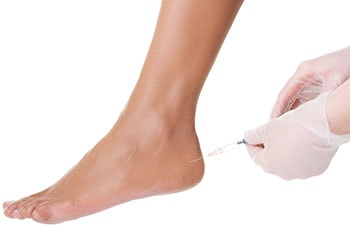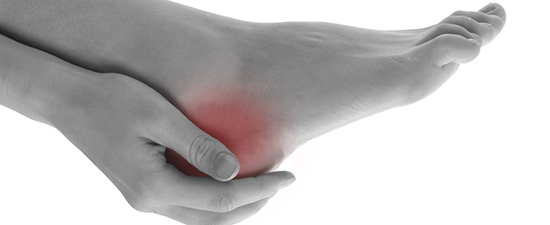The plantar fascia is a strong web of ligament that runs along the bottom of your foot, from your heel bone (calcaneous) to the bones of your toes. It functions as a resilient shock absorber and supports the arch of your foot.
What’s Plantar Fasciitis?
Plantar fasciitis is the name of the condition that occurs when repetitive overuse of the area causes small “micro-tears” and inflammation of the plantar fascia. Plantar fasciitis is caused by playing sports, activity, obesity, flat feet, an anomalous bone structure, to name a few.
The resulting condition’s excruciating causing bottom of foot pain, pain in the back of the heel, ball of foot pain and the most common, pain in the arch of the foot.
1. Conservative care is the first option when treating chronic plantar fasciitis
Rest, ice and heat, in-office physical therapy, stretching at home, orthotics, and use of appropriate footwear fully resolve over 70% of our plantar fasciitis cases. When conservative treatment is not enough to heal plantar fasciitis, we employ an array of state-of-the-art treatments.
Mechanical and electronic technologies are not always the source of modern medical miracles. The most amazing results are when the human body’s own innate healing system. Here are some revolutionary new treatments available at UFAI that does just that!
2. Platelet Rich Plasma Therapy
When our bodies are injured, the body’s healing system rushes blood cells to the affected area to begin the recovery process. But when healing isn’t completed within the limited time the body dedicates to a non-life-threatening injury, the system stops tending to that injury.
Then these healing resources are devoted to other, more immediately needful, areas. The result? A chronic condition of unrelenting pain from the abandoned injury.
Platelet rich plasma (PRP) therapy allows the body to kick start the healing process at the site of the chronic condition. PRP uses an infusion of healing cells collected from the patient’s own blood supply.
These cells are then isolated in a centrifuge. They are then infused into the area of the injury, where they immediately restart healing plantar fasciitis. This protocol is very effective in calming the inflamed plantar fascia, thereby reducing the pain of plantar fasciitis.
3. Stem Cell Therapy
Another way that modern medicine uses our own internal resources to heal ourselves is stem cell therapy. In this procedure, UFAI physicians collect stem cells from our patient’s blood. We winnow out the redundant cells, leaving a powerful collection of regenerative stem cells.
Then our doctor injets these warrior cells into the sole of the foot, where they thrive, multiply, and enlist resident cells in the renewed fight against fascia inflammation.
At UFAI, our stem cell infusions also include hyaluronic acid, which lubricates the plantar fascia, further easing pain and increasing resilience. Like PRP, stem cell therapy is effective for healing plantar fasciitis. It’s well tolerated and involves minimal discomfort.
4. Amniotic Stem Cell Therapy
Amniotic stem cell therapy is one of the latest advances in stem cell therapy. It employs cells found in the amniotic fluid which surrounds fetuses in the womb. (The supplies of amniotic fluid used at UFAI are obtained during cesarean section births).
This liquid is extremely high in stem cell concentration. It also contains an extracellular matrix (ECM), which is not present in either PRP or autologous stem cell therapy. ECM facilitates cell migration to the inflammation site. It is also more effective in alerting the local cells to reenlist in the battle against inflammation.
5. Topaz Coblation Microdebridement
Topaz microdebridement is a minimally invasive surgical process performed in our operating room under sedation and a local nerve block. It takes only about 20 minutes.
This procedure creates a grid pattern of tiny holes over the plantar fascia area. Then the Topaz probe emits a small burst of radio wave energy through the holes. This breaks up scar tissue and reestablishes healthy blood flow into the affected area. The process transforms a chronic condition into a temporarily acute inflammation, which sends a new influx of healing cells directly into the ligament.
UFAI has been researching and helping with the development of Topaz technology for over 10 years. Also, we’ve been involved in several research projects using the Topaz probe for other foot and ankle problems.
6. The TenJet System
TenJet is another minimally invasive surgical procedure which often alleviates the pain of plantar fasciitis. Using ultrasound guidance, the TenJet system focuses a high-pressure stream of saline solution directly into the damaged fascia tissue.
The hydrodynamics of the system separate, debride, and flush out the defective tissue, while leaving the healthy ligament intact.
The doctors at UFAI often add amniotic stem cells or platelet rich plasma injections during the procedure. This augments healing plantar fasciitis and speeds up the recovery process. TenJet is an outpatient process, performed under a local anesthetic.
The best part is iIt only takes about 15 minutes, and the small incision requires no stitches.
7. Dysport Injections

When Dysport is injected into an inflamed plantar fascia, it relaxes the ligament. The reduction of tension relieves the swelling and consequent pain. Dysport relief typically lasts for 3 to 6 months, sometimes even for years.
8. Shockwave Therapy
Shockwave therapy is another effective treatment when chronic plantar fasciitis has persisted despite conservative treatment. It uses electromagnetic shockwaves to cause micro-traumas within a chronically inflamed plantar fascia.
These micro-traumas break down the injured tissue and calcifications that are characteristic of plantar fasciitis. This disruptive process signals your body to dramatically increase the blood supply to the affected ligaments. The increased blood supply provides the healing cells and nutrients which reduce the inflammation and pain of chronic plantar fasciitis.
Low intensity shockwave therapy is an in-office 15-minute procedure. Usually three applications are required. Because there is very little associated pain, anesthesia is unnecessary. In some cases, high intensity shockwave therapy may be indicated.
Because the more intense application of shockwaves can cause more pain, anesthesia may be necessary. However, high intensity shockwave therapy generally requires only one treatment.
With the highest success rates in the nation, UFAI continues to offer only the very best care
The doctors at University Foot and Ankle Institute are thoroughly trained and highly skilled in each and all of the possible ways to alleviate the persistent pain of plantar fasciitis. We carefully analyze the context of your particular condition and prescribe one (or a combination) of our many weapons against plantar fasciitis.
If you are experiencing the pain of plantar fasciitis, we’re here to help.
Our nationally recognized podiatrists and foot and ankle specialists offer the most advanced foot and ankle care along with the highest success rates in the nation. We are leaders in the field of research and treatment of all foot and ankle conditions.
For more information or to schedule a consultation, please call (877) 736-6001 or visit us at www.footankleinstitute.com.
- What To Do When Your Toenail Is Falling Off - October 21, 2024
- How To Tell If You Have Wide Feet - October 3, 2024
- 15 Summer Foot Care Tips to Put Your Best Feet Forward - July 1, 2024

Leave a Reply